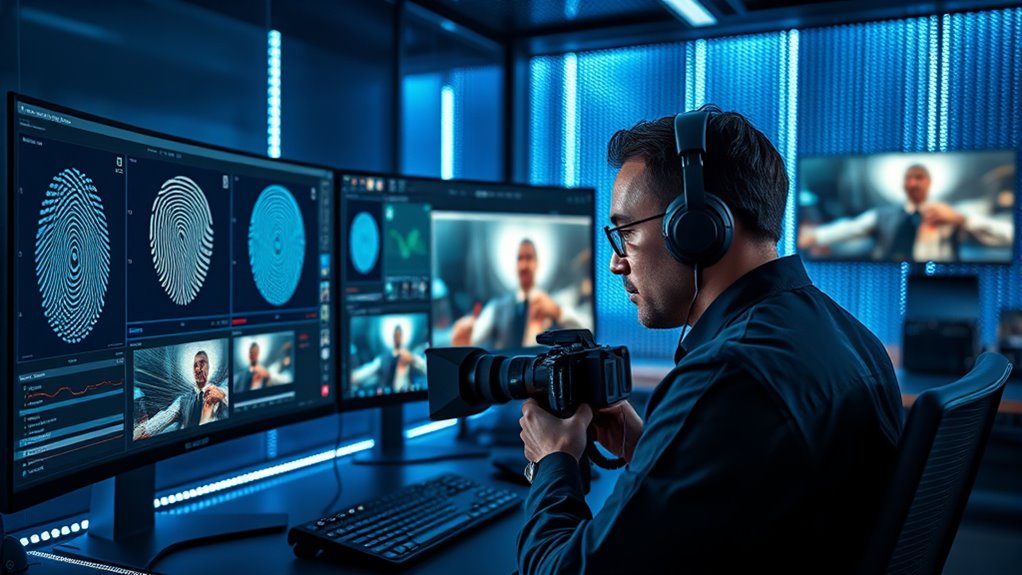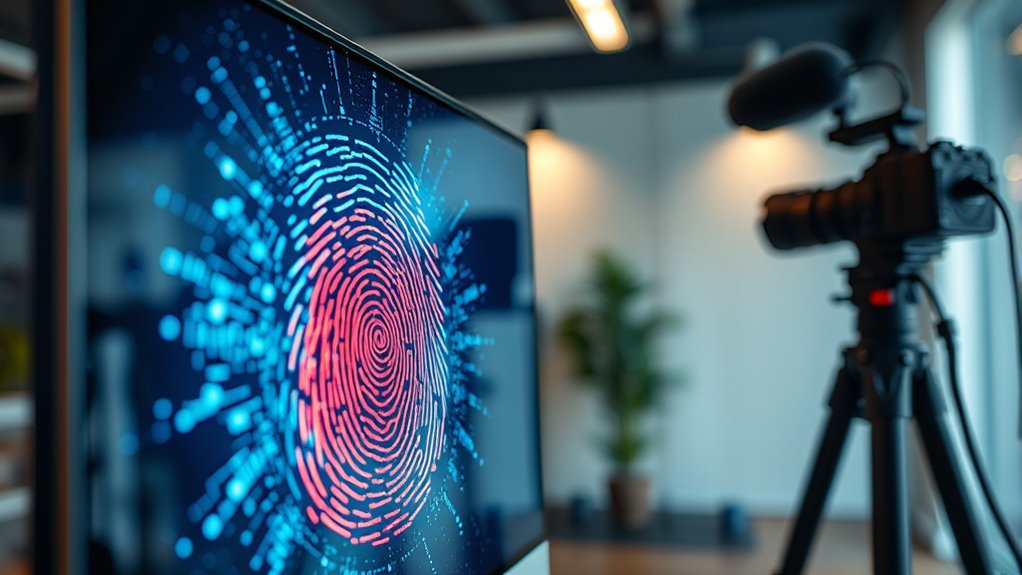To defend against deepfakes, new tools like digital watermarking and AI detection are emerging. Watermarking embeds invisible signatures into videos to confirm authenticity and origin, while AI algorithms analyze videos for inconsistencies or manipulation signs. Combining these methods creates a layered defense, making it harder for fake content to go unnoticed. Staying informed about these innovations can help you better protect and verify digital media—if you keep exploring, you’ll uncover even more ways to stay safe.
Key Takeaways
- Digital watermarking embeds invisible identifiers into videos to verify their origin and authenticity.
- AI detection techniques analyze visual artifacts and inconsistencies to identify deepfake content.
- Combining watermarking with AI algorithms provides a layered approach to authentic video verification.
- New tools automate fingerprinting and detection, making deepfake defense more accessible and effective.
- Continuous technological advancements improve robustness and integration of authentication methods into media platforms.

Have you ever wondered how to protect yourself from the growing threat of deepfake technology? As deepfakes become more realistic and widespread, safeguarding your digital content and verifying authenticity is more essential than ever. One of the most promising methods is digital watermarking, a technique that embeds invisible identifiers into videos or images. These watermarks act like digital signatures, allowing you to verify the origin and integrity of a piece of content. When combined with AI detection techniques, digital watermarking becomes a powerful tool for distinguishing genuine videos from manipulated ones. AI detection techniques analyze the subtle inconsistencies and artifacts that deepfakes often leave behind—like unnatural blinking, inconsistent shadows, or irregular facial movements. These methods leverage machine learning algorithms trained to recognize the telltale signs of synthetic content, making it easier to spot fakes even when they’re highly sophisticated. Together, digital watermarking and AI detection techniques create a layered defense system. When a video carries a validated watermark, you can be more confident in its authenticity, especially if the watermark is cryptographically secured. Meanwhile, AI detection algorithms scan for anomalies that might indicate manipulation, providing an additional verification layer. This dual approach helps prevent the spread of misinformation and protects individuals from false representations. It’s important to understand that no single method offers foolproof security, but combining these technologies considerably raises the difficulty for malicious actors trying to create convincing deepfakes. Digital watermarking is particularly useful for content creators, media outlets, and organizations that need to certify their videos’ authenticity. They can embed watermarks during production, ensuring that viewers or fact-checkers can verify the content’s origin later. Meanwhile, AI detection tools are becoming more accessible and user-friendly, enabling everyday users to scrutinize videos they encounter online. As these technologies continue evolving, they’ll likely become more integrated into social media platforms and content-sharing services, automatically flagging suspicious videos. Staying informed about these innovations arms you with the knowledge to better identify and protect against manipulated content. It’s essential to remember that technology alone isn’t enough; awareness and critical thinking remain fundamental tools in the fight against deepfakes. By understanding how digital watermarking and AI detection techniques work together, you can better navigate the digital landscape, knowing there are emerging tools designed to preserve trust and authenticity in multimedia content. These advancements are critical steps toward safeguarding your digital environment from increasingly convincing and malicious deepfake creations. Additionally, understanding the role of dog names in content can help identify authentic media featuring pets or animals.
Frequently Asked Questions
How Effective Are Current Deepfake Detection Tools Against Advanced Fakes?
You’re wondering how effective current deepfake detection tools are against advanced fakes. While these tools can catch many AI-generated videos, they face detection limitations with increasingly sophisticated deepfakes. AI vulnerabilities allow skilled creators to bypass some defenses, making it a constant race. Although technology improves, you should stay cautious, knowing that no method is foolproof yet, and deepfake creators continue to refine their techniques.
Can Deepfake Fingerprinting Be Applied in Real-Time Video Analysis?
Like a vigilant lighthouse guiding ships through fog, deepfake fingerprinting can be applied in real-time video analysis. When you monitor a video stream, these tools act as a digital fingerprint, instantly verifying authenticity. While technically complex, advancements now enable near real-time analysis, helping you detect fakes swiftly. This ongoing progress means you can better trust video integrity, ensuring your decisions aren’t clouded by convincing but false content.
What Are the Privacy Concerns Related to Deepfake Fingerprinting Methods?
You should consider that deepfake fingerprinting raises significant privacy concerns. It involves analyzing data privacy risks because it could track or identify individuals without their full consent. This method might also lead to consent issues, especially if users aren’t aware their videos are being fingerprinted. Protecting personal data and ensuring explicit consent are essential to prevent misuse, safeguard privacy, and maintain public trust in video authentication technologies.
How Do Different Industries Implement These Deepfake Detection Tools?
You’ll find that industries implement deepfake detection tools differently, often tailored to their needs. Media companies prioritize authenticity, using fingerprinting to verify videos before publishing, while social media platforms deploy these tools to flag and remove deceptive content quickly. Healthcare and finance sectors also adopt these technologies to prevent fraud. However, you should consider the ethical implications, such as privacy concerns, and promote media literacy to help users identify deepfakes confidently.
Are There Legal Standards for Verifying Video Authenticity Using Fingerprinting?
Think of verifying video authenticity as steering a ship’s compass. While there’s no universal legal standard yet, you must prioritize legal compliance and ethical considerations to steer safely. Laws vary by jurisdiction, and emerging regulations aim to set clear standards for fingerprinting techniques. Staying informed and adhering to these evolving guidelines helps you guarantee authenticity, protect privacy, and avoid legal pitfalls, much like a skilled sailor charting a course through unpredictable waters.
Conclusion
As you navigate the digital world, these new fingerprinting tools give you a vital edge against deepfakes. With over 90% of videos being digitally manipulated by 2025, staying vigilant is more important than ever. By using advanced detection methods, you can confidently verify authentic content and protect yourself from misinformation. Embrace these innovations to stay one step ahead and guarantee the videos you trust are real.









